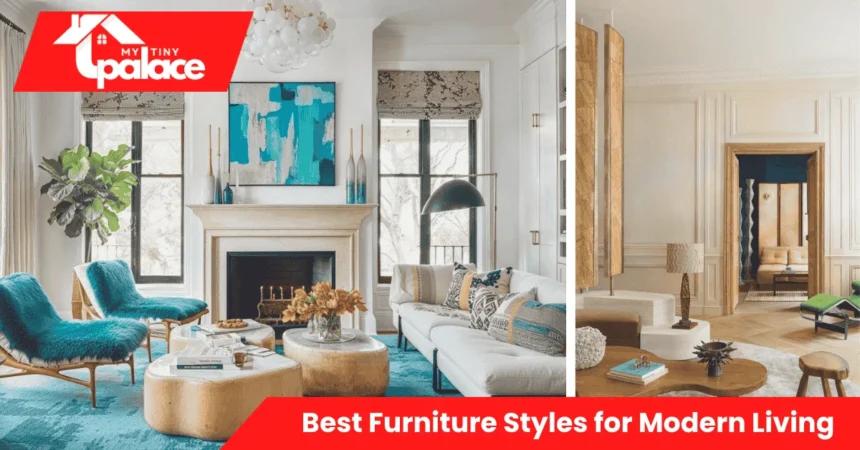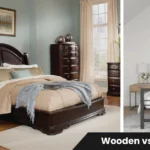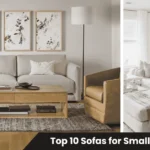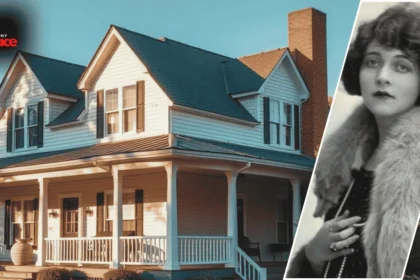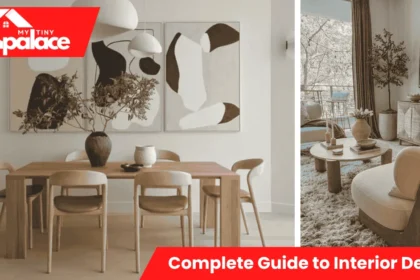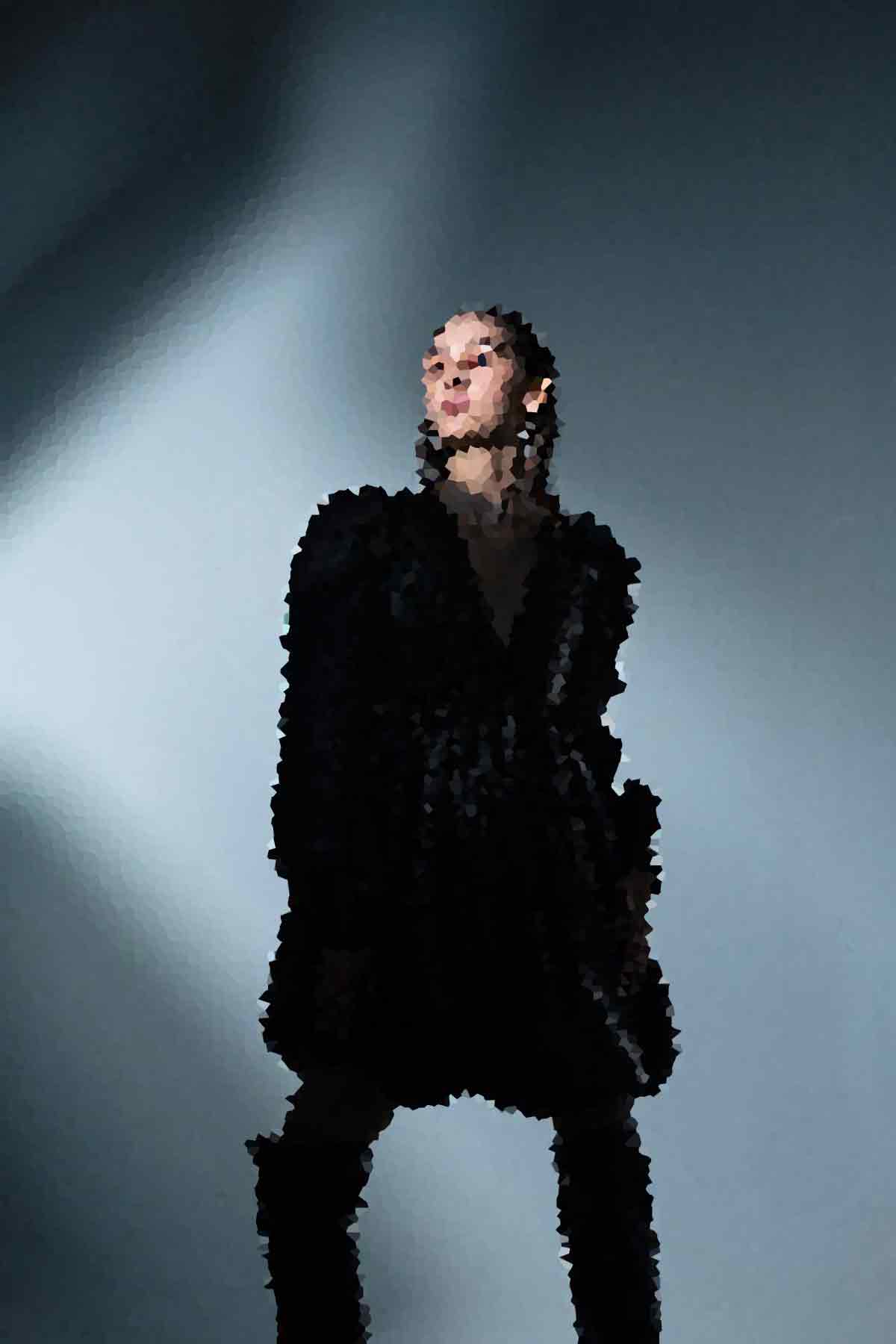Modern living rooms need furniture that works hard without looking cluttered. Your sofa should hold up to movie nights and coffee spills. Your coffee table needs to fit between the seating without blocking foot traffic. Choosing the right style means your space feels open, functions smoothly, and actually reflects how you live—not just how design magazines say you should live.
- Quick summary
- Best Furniture Styles for Modern Living
- Why style choice matters in modern living
- Core furniture styles that suit modern living
- How to choose the right style for your home
- Styling plan: pull a modern room together (step-by-step)
- Costs, time, and durability — compact comparison table
- Pros & cons — who should consider each style
- Quick summary + CTA (what to do next)
Quick summary
Pick furniture with clean lines, durable materials, and sizes that match your actual floor space. Invest in one anchor piece like a quality sofa or dining table, then build around it with budget-friendly accents. Match your style to your lifestyle—minimalist works for neat freaks, while Scandinavian warmth suits families who need comfort and washable surfaces.
Best Furniture Styles for Modern Living
Modern living means different things depending on who you ask. This guide describes spaces that prioritize function over fuss. You want pieces with straightforward silhouettes, materials built for daily use, and neutral colors that pair with almost anything. Modern furniture skips heavy ornamentation, carved details, and fabric that stains if you look at it wrong.
This approach suits small-home dwellers who can’t waste an inch, families juggling toys and work-from-home setups, and anyone tired of dusting intricate details. Contemporary design focuses on what works now—modular sofas for flexibility, performance fabrics for spills, and storage that hides clutter without adding visual bulk.
Why style choice matters in modern living
Your furniture style impacts how you move through your space every single day. A bulky sectional might block the path to your kitchen. A glass coffee table with sharp corners becomes a hazard with toddlers run laps. Choose poorly and you’ll stub toes, strain your back reaching over deep sofas, and spend weekends spot-cleaning delicate upholstery.
The right style improves traffic flow. Low-profile pieces keep sightlines open in studios and small apartments. Streamlined designs mean less surface area collecting dust. Durable materials handle pets, kids, and the wear of actual living without looking shabby after six months.
Style choice also affects resale and staging value. Neutral modern pieces appeal to more buyers than bold pattern-heavy furniture. If you rent, investing in adaptable contemporary pieces means you can move them to different homes without clashing with new wall colors or layouts. Function-first furniture also supports work-from-home life—modular desks, ergonomic chairs, and multipurpose tables that shift from dining to workspace.
Core furniture styles that suit modern living
Scandinavian brings warmth through light woods like oak and ash, paired with white or soft gray upholstery. This style balances minimal forms with cozy textiles—think wool throws and linen cushions. It works for modern living because pieces stay light and airy, perfect for small spaces or rooms with limited natural light. Renters love it since most items come flat-packed and assemble without professional help.
Mid-Century Modern features tapered legs, organic curves, and mixed materials like walnut wood with leather or brass accents. Originally from the 1950s and 60s, this style still fits today because the proportions suit standard room sizes. A mid-century sofa typically measures 32–36 inches deep, which leaves space for coffee table clearance without cramping the room. Works well if you want personality without overwhelming a small apartment.
Contemporary Minimal strips things down further—monochrome palettes, sleek metal frames, and almost no decorative elements. Best for neat freaks and people who prefer open space over collections of objects. The downside: can feel cold without layering in textured rugs, plants, or warm lighting. Great for studios where every piece needs to earn its place.
Industrial Chic mixes raw materials like exposed metal, reclaimed wood, and concrete finishes. You’ll see pipe-frame shelving, distressed leather, and unfinished edges. This style suits lofts and open-plan spaces with high ceilings. Maintenance is lower since scratches and wear add to the aesthetic. Not ideal if you want polished elegance or have very young kids—metal corners and hard surfaces pose more risks.
Japandi blends Japanese minimalism with Scandinavian coziness. Expect low furniture, natural fibers, and a neutral palette with occasional black accents. Pieces prioritize craftsmanship and quality over quantity. Works beautifully in modern living because the focus on fewer, better items matches small-space realities. Storage is usually hidden or integrated, keeping clutter out of sight.
How to choose the right style for your home
Start with room size. Measure your space before falling in love with a sectional. A standard three-seater sofa runs 84–96 inches wide. Add 12–18 inches of clearance between the sofa and coffee table so people can walk without sideways shuffling. In a 12×14-foot living room, you can fit a sofa, coffee table, and two accent chairs if you choose streamlined pieces. Go bigger and you’ll block doorways or windows.
Consider the function next. A family with two kids needs stain-resistant performance fabric, not ivory linen. If you work from home, prioritize a dining table that doubles as a desk—choose one with a smooth surface and comfortable height (29–30 inches standard). Pet owners should skip delicate velvet and opt for tight-weave fabrics or leather that wipes clean.
Match your existing architecture. Exposed brick or concrete walls pair naturally with industrial or mid-century pieces. Older homes with ornate molding can handle contemporary furniture as long as you keep finishes consistent—all chrome or all matte black, not mixed randomly.
Budget matters too. Decide where to splurge and where to save. A quality sofa runs $1,200–$3,000 and should last 10–15 years with proper care. Side tables and accent chairs can come from budget retailers at $150–$400 each since they take less wear. Skip trendy finishes like rose gold or overly specific colors—stick with wood tones, black, white, or gray for longer relevance.
For example: A 450-square-foot studio apartment calls for a low-profile loveseat (60–72 inches), a slim coffee table with storage underneath, and wall-mounted shelves instead of bulky bookcases. A family living room in a suburban home can handle a larger sectional, an oversized ottoman for extra seating, and a media console that hides toys and remotes.
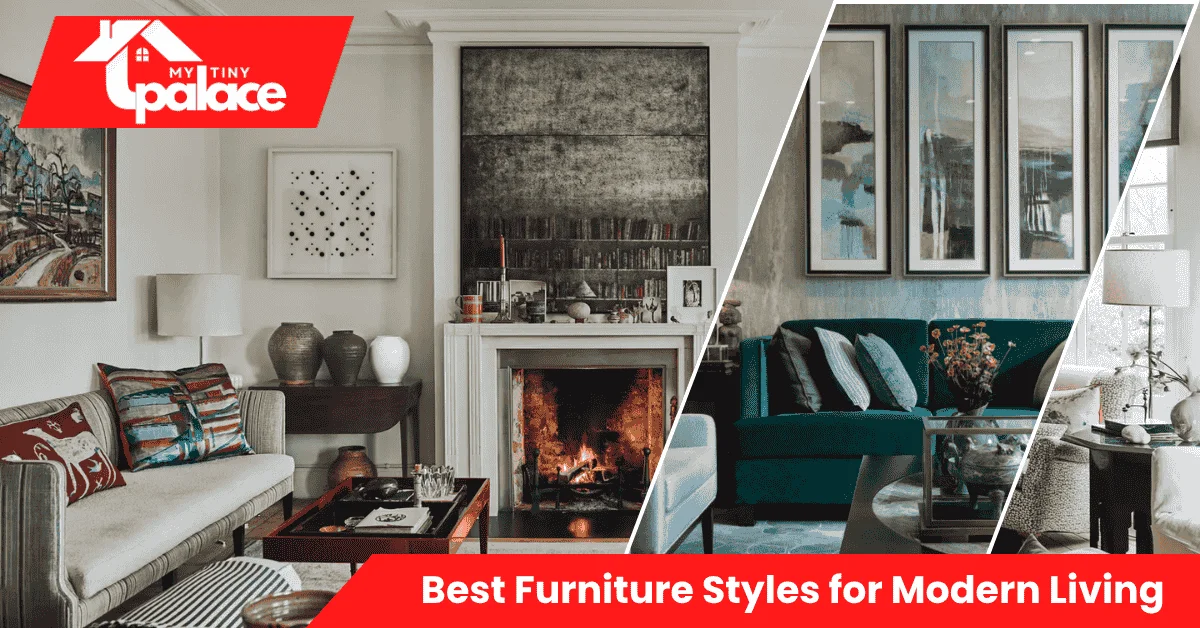
Styling plan: pull a modern room together (step-by-step)
Step 1: Assess and measure. Walk your room with a tape measure. Note doorways (standard 32–36 inches), windows, electrical outlets, and traffic paths. Sketch a rough floor plan or use a free app. Mark where you need clearance for doors to swing open.
Step 2: Pick your anchor piece. This is usually the sofa or dining table—the largest, most-used item. Choose this first because everything else scales around it. Test sofa depth in person if possible. Shallow sofas (30–32 inches) work for small spaces but sacrifice lounge comfort. Deeper sofas (36–40 inches) are great for sprawling, but they at up floor space.
Step 3: Select complementary pieces. Add a coffee table no more than two-thirds the length of your sofa. Choose a height within 1–2 inches of your sofa seat (typically 16–18 inches). Add seating—accent chairs or a bench—that matches the visual weight. If your sofa is bulky leather, balance it with lighter wood or metal chairs.
Step 4: Incorporate storage. Modern living needs hidden storage. Use a media console with drawers, an ottoman that opens, or nesting tables that tuck away. Keep surfaces clear to maintain the streamlined look.
Step 5: Layer textiles and lighting. Add throw pillows (limit to 3–5 per sofa to avoid clutter), a textured rug to define the seating area, and blackout or sheer curtains depending on light needs. Place a floor lamp in a corner for ambient light and a table lamp for reading. Avoid overhead lighting alone—it flattens the space.
Step 6: Refine with art and plants. Hang artwork at eye level (57–60 inches to the center). Add one or two low-maintenance plants like snake plants or pothos. Don’t overcrowd—modern style relies on breathing room.
Materials & measurements checklist
- Measure doorways, hallways, and stairwells before ordering large furniture
- Standard sofa depth: 32–40 inches; shallower for small rooms
- Coffee table clearance: 12–18 inches from sofa edge
- Dining chair clearance: 24–30 inches from table edge to wall
- Leather: durable, wipes clean, develops patina; can feel cold or sticky
- Performance fabric: stain-resistant, family-friendly; may pill over time
- Solid wood: sturdy, repairable; heavier and pricier than engineered wood
- Metal frames: industrial look, strong; can scratch floors without felt pads
Costs, time, and durability — compact comparison table
| Item | Starter ($) | Mid-Range ($) | Investment ($) | Lifespan | Maintenance |
|---|---|---|---|---|---|
| Sofa | 400–800 | 1,200–2,000 | 2,500–5,000 | 7–15 years | Vacuum weekly; spot-clean spills |
| Dining Table | 200–500 | 600–1,200 | 1,500–3,500 | 10–20 years | Wipe daily; refinish wood every 5–10 years |
| Accent Chair | 150–350 | 400–800 | 1,000–2,000 | 5–12 years | Rotate cushions; steam-clean annually |
| Coffee Table | 100–250 | 300–600 | 700–1,500 | 10–15 years | Coasters for drinks; dust weekly |
Where to splurge: Invest in your sofa and bed since you use them for hours daily. A quality mattress and sturdy sofa frame with eight-way hand-tied springs outlast cheaper alternatives by years.
Where to save: Side tables, decorative lighting, and accent pieces can come from budget retailers. You’ll replace or update these more often as your taste shifts, so don’t overspend upfront.
Pros & cons — who should consider each style
Minimalist Contemporary suits people who like clean counters and few belongings. Pro: easy to maintain and visually calming. Con: can feel stark without warm accents. Not ideal for collectors or families with lots of gear.
Mid-Century Modern works for style-conscious buyers who want character. Pro: timeless appeal and good resale value. Con: authentic vintage pieces cost more and may need repairs. Watch for wobbly legs on older finds.
Scandinavian fits families and renters needing comfort and flexibility. Pro: widely available, affordable, and easy to assemble. Con: Light colors show stains faster. Keep performance fabric on hand if you have kids or pets.
Industrial Chic appeals to urban dwellers and loft residents. Pro: durable and low-maintenance. Con: Hard surfaces aren’t toddler-friendly. Metal and concrete feel cold in small, poorly lit spaces.
Japandi suits mindful buyers who value craftsmanship over quantity. Pro: high-quality, long-lasting pieces. Con: pricier upfront and limited selection outside specialty retailers.
Safety note: If you’re installing wall-mounted shelving, built-in benches, or making structural changes like removing walls, hire a licensed contractor. Check local building codes and permits before starting work. DIY assembly is fine for flat-pack furniture, but never compromise on wall anchors—tip-over accidents cause serious injuries.
Quick summary + CTA (what to do next)
Modern living thrives on furniture that balances form and function. Scandinavian warmth, mid-century character, and contemporary minimalism all work if you match the style to your space and lifestyle. Prioritize durable materials, measure carefully, and invest in one anchor piece that grounds the room.
Your next step: Measure your main living area right now—length, width, and doorway dimensions. Decide on your anchor piece (sofa or dining table) and set a realistic budget. Once you know your constraints, shopping becomes faster and less overwhelming. Download a simple floor plan app or sketch on graph paper to visualize furniture placement before buying. This prevents costly returns and ensures every piece earns its spot in your home.






